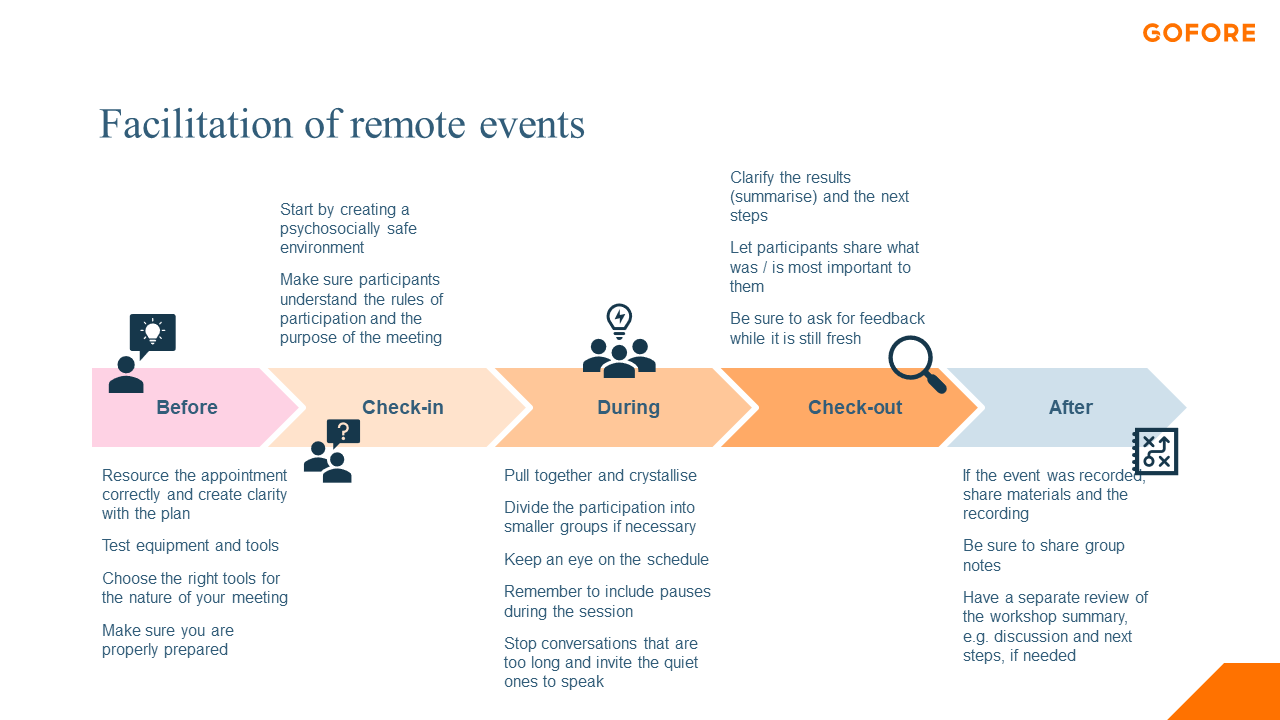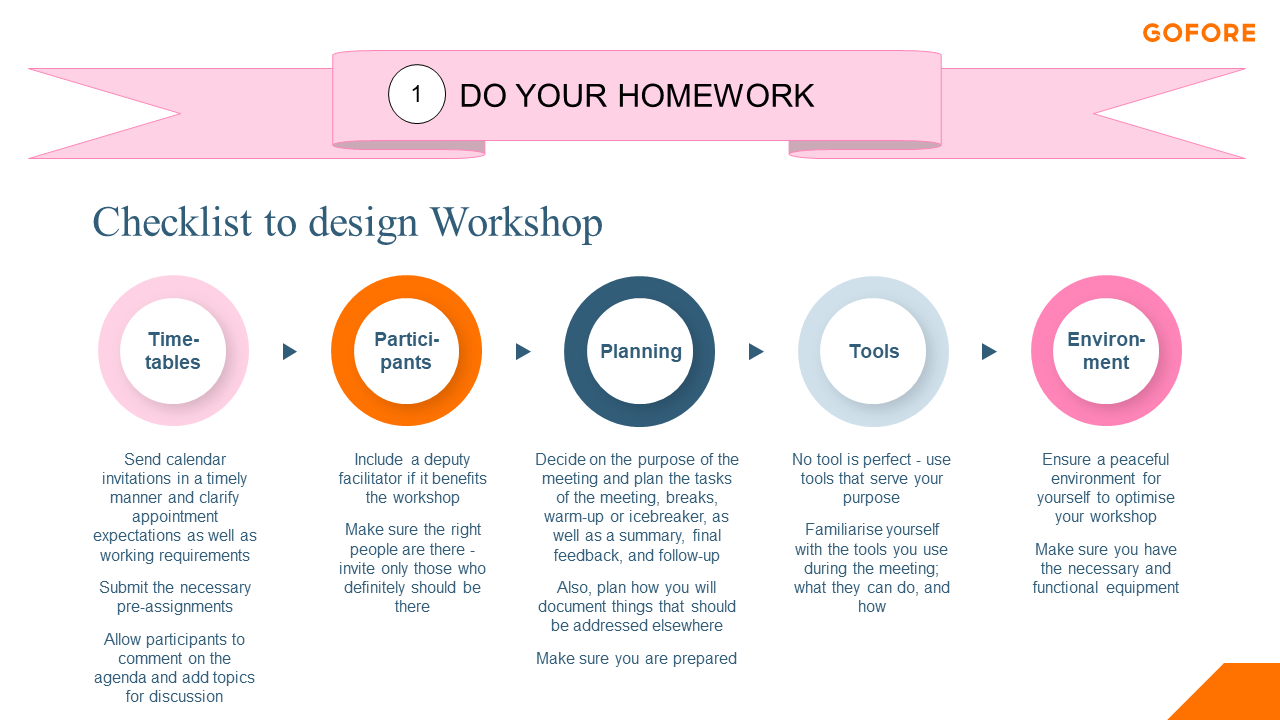This is Part 1 of a three-part blog series that describes how to plan and run a workshop with a group assignment while using digital co-working tools. In other words, it’s a facilitated workshop, but done online where everyone participates from their own desk. We hope that we can convey new and useful ideas to you for organising and facilitating your own virtual workshops.
This blog is a combination of what we learned from virtual meetings facilitation and from our own findings when doing online workshops. Try out these tips and find your own optimal way of doing virtual and online workshops.

Before the workshop
In this first part of the blog series, we will open up the process of planning the workshop: what kind of resources you need, how much time should you reserve for planning and how you invite your participants to join.
Resourcing
Get the right co-worker mix – Notice that planning a virtual workshop demands somewhat more time, effort and people than for a normal workshop. You might be able to facilitate a physical workshop for even twenty participants on your own; however, for this we recommend having at least one co-facilitator in addition to yourself. One of you can be the “lead facilitator” while the “co-facilitator” supports the participants and follows the online chat.
Participants
Ensure an optimal number of participants – The optimal number of participants for a virtual workshop involving group assignments is from six to twenty participants. If there are more than twenty participants, you should opt for hosting a webinar, not a workshop or virtual meeting. Groupwork is best facilitated with a group no bigger than ten participants. Six to seven participants is the optimal number per group; in a group of this size, everyone gets to participate, and you have time to help those who have difficulties in participating (for example due to technical glitches or network connection issues). If your workshop has more than ten participants, consider dividing your participants into smaller groups for the online work assignments, for example by using break-out rooms.
Pre-work
Ensure participants are prepared – Invitations are one of the most important aspects of preparing your workshops. Firstly, ensure the participants are able to reserve the workshop appointment into their calendars. Even you haven’t yet fully planned the workshop agenda, you should already send the first calendar invitation sufficiently in advance to reserve the participants’ time for the workshop. Ensure the purpose of the workshop is stated clearly; state the objective of the session and clearly communicate the workshop expectations. For example:
- I hope you can participate 100 %…
- Use a headset for clear audio…
- Participate from a peaceful environment…
- Use of a mouse is recommended…
It’s also useful to add several instructions to the invitation that may save you a few grey hairs:
- Please do not to forward this calendar invitation without the facilitator’s permission…
- Please accept or decline this invitation…
Optionally, you can also assign some pre-work to participants before the actual workshop. One useful task is to introduce participants to the tools that will be used during the workshop. You can create a test board with a few small tasks, or invite your participants to try out the tools in a fifteen minute pre-meeting. In this test session, you can walk through the tools with your participants and at the same time usefully test the availability of network connections.

Planning
Do your homework – Virtual workshops need to be shorter and include more breaks than physical ones. The maximum time for one workshop is three hours, and you’ll need at least two breaks, possibly three, during that time. Do short “bio pauses” once an hour and one longer pause to allow participants to get coffee, check email, etc.
Avoid long monologues and presentations. Instead, split the presentation into smaller segments and insert discussion or groupwork between the presentation segments. Presenting and groupwork assignments should be no longer than two to ten minutes at a time. If you include discussion or use digital tools during groupwork (Mural, Miro etc.), ten to twenty minutes per session is the optimal time-span.
If your workshop participants exceed six to ten, divide your audience into smaller groups and into separate sessions during the workshop. For this, you need to plan breakout sessions and you need so-called “breakout rooms”. For example, Zoom and also Teams have a feature for dividing meetings into smaller sessions.
TIP: If you’re using some other conferencing tool without a breakout room option, you can prepare the calendar invitations for separate sessions beforehand and share them via the Skype/other conferencing tool’s chat. Or you can ask someone from the group to invite a separate conferencing session.
Remember that tense participants don’t contribute – One significant factor to consider when planning virtual workshops, or workshops in general, is psychosocial safety. Workshop participants need to feel sufficiently safe and confident to open their mouths, to ask questions, to present alternative views, to challenge (constructively), and so on. You, as a facilitator, are responsible for creating psychological safety in your workshop. A good idea is to begin with a few minutes of informal discussion using a light or fun topic before the actual workshop starts. Or you could arrange a short game at the beginning of the workshop, or encourage everyone to say something about their state of mind. Whatever method you use, the objective is the same: that every participant feels included and confident.
Plan, plan, plan – Plan for more than the day. Plan for what happens after workshop. Create the methods used list, other checklists, and time slots. Remember, the more detailed your plan, the more you’ll ensure that your workshop will run on schedule – and be successful.
Workshop tools and personal equipment
The environment matters too – Always test beforehand your personal equipment (headset, display, cables, instant message tool, etc.), workshop tools (Skype, Teams, Mural, Miro etc.) and online network connections. Have a plan B if something goes wrong (for example if you cannot share you screen). Your plan B might include an alternative conferencing tool link (for example switch from Skype to Zoom) or other co-working equipment. Sometimes you might need to enable some participant to join via telephone line. In this case, use the phone speaker and send the material and links to group assignment work beforehand.
Prepare any links for online boards and co-working tools beforehand and test them in different browsers (for example, MURAL doesn’t work optimally in Safari browsers). It’s good to warn your participants beforehand about all of the required tools for the workshop. For example, tell your participants that in addition to Skype, you’ll be using a digital whiteboard like Miro.
Finally
Thorough planning saves your nerves and gives you the confidence to work as a workshop leader or facilitator.
In the next part of this blog series, Part 2 During the workshop, we focus on things you should consider during the workshop or presentation.



